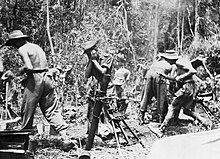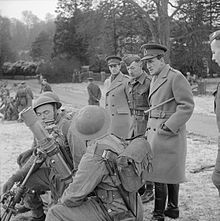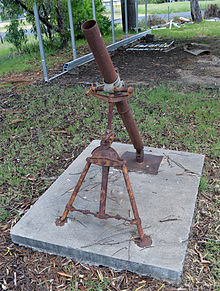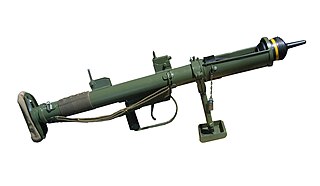
The Projector, Infantry, Anti Tank (PIAT) Mk I was a British man-portable anti-tank weapon developed during the Second World War. The PIAT was designed in 1942 in response to the British Army's need for a more effective infantry anti-tank weapon and entered service in 1943.

A mortar is usually a simple, lightweight, man-portable, muzzle-loaded weapon, consisting of a smooth-bore metal tube fixed to a base plate with a lightweight bipod mount and a sight. Mortars launch explosive shells in high-arching ballistic trajectories. Mortars are typically used as indirect fire weapons for close fire support with a variety of ammunition.

The Brixia Model 35 was an Italian small-sized, rapid firing light mortar of World War II. The Brixia Modello 35 was used to provide light supporting fire to the infantry companies. It was issued at battalion level, with each battalion containing nine mortars and these were parceled out to each infantry company. It had a good rate of fire but lacked power due to the small round. It was widely used and saw action on every major Italian front.

The Universal Carrier, also known as the Bren Gun Carrier and sometimes simply the Bren Carrier from the light machine gun armament, is a common name describing a family of light armoured tracked vehicles built by Vickers-Armstrongs and other companies.

The Grenade, Hand, Anti-Tank, No. 75, also known as the "Hawkins grenade" was a British anti-tank hand grenade used during World War II. It was one of a number of grenades developed for use by the British Army and Home Guard in the aftermath of the Dunkirk evacuation. The grenade first appeared in 1942, and was designed to be more versatile than previous grenades, such as the No. 73 grenade and the sticky bomb.

The No. 73 grenade, also known as the "Thermos", "Woolworth bomb", or "hand percussion grenade", was a British anti-tank grenade used during the Second World War. It got its nickname from the resemblance to a Thermos flask.

The M1 mortar is an American 81 millimeter caliber mortar. It was based on the French Brandt mortar. The M1 mortar was used from before World War II until the 1950s when it was replaced by the lighter and longer ranged M29 mortar.

The Ordnance SBML two-inch mortar, or more commonly, just "two-inch mortar", was a British mortar issued to the British Army and the Commonwealth armies, that saw use during the Second World War and later.

The M2 mortar is a 60 millimeter smoothbore, muzzle-loading, high-angle-of-fire weapon used by U.S. forces in World War II, the Korean War, and the Vietnam War for light infantry support.
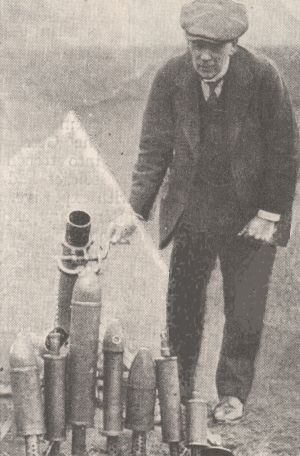
The Stokes mortar was a British trench mortar designed by Sir Wilfred Stokes KBE that was issued to the British and U.S. armies, as well as the Portuguese Expeditionary Corps, during the latter half of the First World War. The 3-inch trench mortar is a smooth-bore, muzzle-loading weapon for high angles of fire. Although it is called a 3-inch mortar, its bore is actually 3.2 inches or 81 mm.

The 8 cm Granatwerfer 34 was the standard German infantry mortar throughout World War II. It was noted for its accuracy and rapid rate of fire.

The M2 4.2-inch mortar was a U.S. rifled 4.2-inch (107 mm) mortar used during the Second World War, the Korean War, and the Vietnam War. It entered service in 1943. It was nicknamed the "Goon Gun" or the "Four-Deuce". In 1951 it began to be phased out in favor of the M30 mortar of the same caliber.

The M-37 or 82-BM-37 is a Soviet 82 millimeter calibre mortar designed by B.I. Shavyrin and accepted into service in 1937. The design of the M-37 is based on the earlier French Brandt mle 27/31 mortar with Russian modifications. The main difference between the 82-PM-37 and the earlier 82-PM-36 was the adoption of a round base plate, revised traverse/elevation controls, simplified sights and spring-loaded shock absorbers on the bi-pod to reduce the amount of relaying needed between shots. It was designed to be able to fire western 81 mm captured ammunition whilst not permitting the enemy the same advantage The German designation for captured M-37 mortars was 8.2 cm GrW 274/2(r).
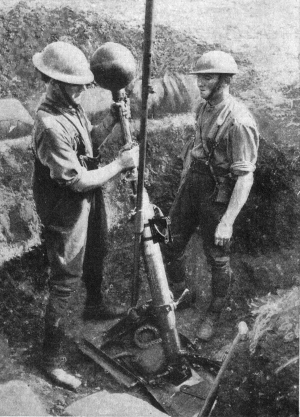
The 2 inch medium trench mortar, also known as the 2-inch howitzer, and nicknamed the "toffee apple" or "plum pudding" mortar, was a British smooth bore muzzle loading (SBML) medium trench mortar in use in World War I from mid-1915 to mid-1917. The designation "2-inch" refers to the mortar barrel, into which only the 22-inch bomb shaft but not the bomb itself was inserted; the spherical bomb itself was actually 9 inches (230 mm) in diameter and weighed 42 lb (19 kg), hence this weapon is more comparable to a standard mortar of approximately 5-6 inch bore.

The Brandt mle 27/31 mortar was a regulation weapon of the French army during the Second World War. Designed by Edgar Brandt, it was a refinement of the Stokes mortar. The Brandt mortar was highly influential, being licensed built or copied by numerous countries.

The British Army used a variety of standardized battle uniforms and weapons during World War I. According to the British official historian Brigadier James E. Edmonds writing in 1925, "The British Army of 1914 was the best trained best equipped and best organized British Army ever sent to war". The value of drab clothing was quickly recognised by the British Army, who introduced Khaki drill for Indian and colonial warfare from the mid-19th century on. As part of a series of reforms following the Second Boer War, a darker khaki serge was adopted in 1902, for service dress in Britain itself. The British military authorities showed more foresight than their French counterparts, who retained highly visible blue coats and red trousers for active service until the final units received a new uniform over a year into World War I. The soldier was issued with the 1908 Pattern Webbing for carrying personal equipment, and he was armed with the Short Magazine Lee–Enfield rifle.

The Ordnance ML 4.2-inch mortar was a heavy mortar used by the British Army during and after World War II.
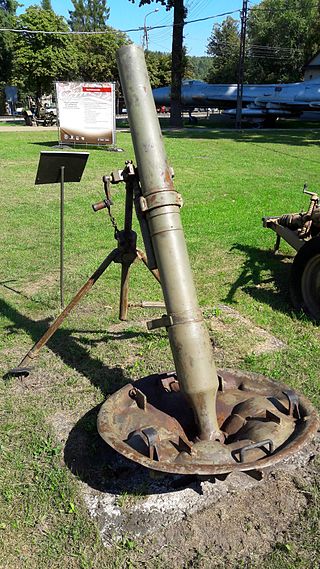
The Soviet 107mm M1938 mortar was a scaled-down version of the 120mm M1938 mortar intended for use by mountain troops and light enough to be towed by animals on a cart.

The 81/14 Model 35 Mortar was an Italian World War II infantry mortar. It was the standard weapon of the Italian Army during the war, of typical Brandt-system construction, but relatively lightweight, with good range and considered very successful.

The L16 81mm mortar is a British standard mortar used by the Canadian Army, British Army, and many other armed forces. It originated as a joint design by the UK and Canada. The version produced and used by Australia is named the F2 81mm Mortar; that used by the U.S. armed forces is known as the M252.


